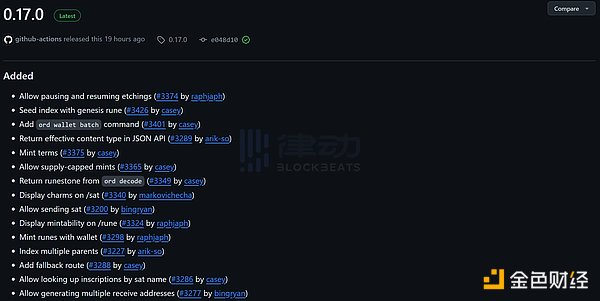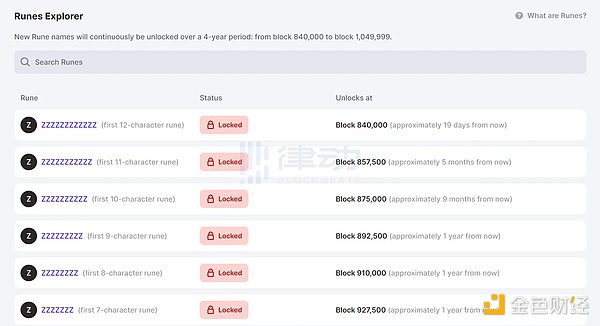Author: c00k1e Source: X, @lonelyhorseme
Yesterday, the Ordinals protocol v.017.0 was officially released, including the final implementation plan of the long-awaited "Rune" protocol.

The editor has quickly compiled a few QA questions about "runes" for you:
Can you type "runes" now? Not yet, "Rune" will be officially activated at Bitcoin block height 840,000, which is expected to be about 19 days away.
What will be the first "rune"? The first "rune" is "UNCOMMON GOODS" that is "hard-coded" (that is, written directly in the code) by Ordinals protocol founder Casey Rodarmor. We can start from the Bitcoin block height of 840, 000 to start playing this "Rune of Creation". However, it must be noted that the "Creation Runes" are limited in time and will be played from the upcoming halving block in 2024 to the next halving block, with one rune for each transaction. Casey is still considering whether to implement the previous plan of "hard-coding" numbers 0-9, that is, all the first 10 "runes".
Will everyone fight fairly after "Rune" is deployed like BRC-20? Depending on the deployer's settings. It not only supports deployment at the same time, which facilitates centralized distribution by the project side, but also supports fair casting for everyone after deployment like BRC-20. At this point, "Rune" is much more flexible than BRC-20. It also supports public casting but is reserved by the project side (such "Rune" Token will be marked), as well as the aforementioned "limited time and unlimited quantity".
Why is the first officially unlocked "rune" ticker "ZZZZZZZZZZZZ"? The maximum length of the "rune" ticker is 26 characters (Casey's hard-coded "UNCOMMON•GOODS" has nothing to do with this rule. It is also worth noting that "•" as a separator is not included in the 12 characters. This is In order to make the ticker more recognizable, such as "WO•YAO•DIS•YOU"), but it is a reverse unlocking process over time (blocks), gradually unlocking from long tickers to short tickers. To put it simply, after "Rune" is officially activated at block height 840,000, all 13 - 26 character tickers can be deployed immediately, but "ZZZZZZZZZZZZ" is the first 12 character ticker that can be deployed . The 12-character tickers will be fully unlocked in blocks 840,000 - 857,500, that is, after every 17,500 blocks, the shorter 1-character tickers will begin to be gradually unlocked. So for familiar 4-character tickers like $PEPE, we have to wait about 3 years.

Compared with BRC-20, this ticker unlocking method is completely reverse. BRC -20 has just opened a 5-character ticker. If BRC-20 continues to open longer ticker deployments in the next few years, will the two collide at some point in time? This is quite interesting.
In the recent update of BRC-20, it not only supports 5-character tickers, but also supports "self-release", that is, the project team deploys it by themselves, and also supports the combustion mechanism. In the short term, these updates of BRC-20 are more conducive to generating hype than Runes. They not only facilitate the centralized issuance of project parties, but also allow old project parties to develop some deflationary gameplay to stimulate market performance. This is BRC-20 Current Advantages.
The advantage of Runes is that first of all, it is a standard at the Ordinals protocol level. An inappropriate analogy is ERC 404 and DN on Ethereum. 404 , the former is the creator of the recent "coin-in-one" craze, while the latter is a cheaper protocol that fully complies with the Ethereum standards and is working towards officially becoming an EIP. As the official "son" of Ordinals, Runes will not suffer from the stability problems caused by changes in the Ordinals protocol like BRC-20, and can fully enjoy the possible improvements brought to it by the new features of the Ordinals protocol for the first time. At the same time, it is also based on UTXO, players do not need to engrave the transfer inscription first and then send the transfer inscription to complete the transaction, which greatly saves costs.
More importantly, although Runes is a standard at the Ordinals protocol level, its implementation itself does not depend on the Ordinals protocol. Like Taproot Assets and RGB, is independent. The implementation of BRC-20 relies on the Ordinals protocol. In the long run, the development of BRC-20 will appear passive.
In past articles, the editor has mentioned Casey's dissatisfaction with BRC-20 - the large amount of "junk" UTXO produced. Therefore, in September 2023, Casey released the concept of "Rune", which is native to Bitcoin's unspent transaction output (UTXO) model, minimizing the generation of "junk" UTXO, thereby achieving a more responsible UTXO management and smaller on-chain footprint.
Now, the "rune" is coming. Everyone often jokes that Ordinals is an ecosystem that “quarrels all the time”, and the imminent launch of “Runes” also means that this conflict of ideas will turn into a real war, and the competition between Runes and BRC-20 will begin. .
 JinseFinance
JinseFinance
 JinseFinance
JinseFinance JinseFinance
JinseFinance JinseFinance
JinseFinance decrypt
decrypt Bitcoinist
Bitcoinist Bitcoinist
Bitcoinist Cointelegraph
Cointelegraph Cointelegraph
Cointelegraph Bitcoinist
Bitcoinist Cointelegraph
Cointelegraph